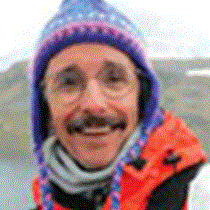Exploring the Weddell Sea
Antarctica filled its lungs today, taking deep gulps of cold polar air to blow a gale and hold her breath, and blow again and again. Early morning found us transiting Antarctic Sound into the icy waters of Erebus and Terror Gulf, in the northwest Weddell Sea. A golden sunrise leaked through bruised clouds as snow petrels flew off our beam. Loose pack ice made a slalom course through which the National Geographic Endeavour found steady passage all the way to Devil Island, off Cape Well-Met, on the north side of Vega Island. As we prepared to head ashore in our trusty Zodiacs (inflatable boats), the wind kicked up and forced us to abandon the landing and head west into Prince Gustav Channel.
Again and again Captain Lampe nosed the ship into fast ice until after lunch he found safe mooring. Able-bodied seamen lowered the gangway. The expedition staff then reconnoitered a safe route, and for the next ninety minutes we explored this thin crust of sea ice no more than three feet thick, suspended above the cold waters of the Weddell Sea, 2,100 feet deep. We found a couple icebergs locked into the sea ice and had a good time climbing up and sliding down. A few passengers even took the opportunity to pelt one another with snowballs. The winds ruled the day, and soon we skedaddled back to the ship as gusts climbed to 35 knots and new leads (open water) widened off the bow and stern of the ship.
We attempted another landing at Devil Island, and again the winds were unforgiving. Our transit back north took us through Fritdjof Sound and a sunlit garden of tabular icebergs, some only tens of meters to port and starboard.
After dinner, the winds once again prevented a landing, this time at Brown Bluff, at the extreme end of the Antarctic Peninsula. Ominous clouds spilled down the icy cliffs and raced our way as we turned north for Bransfield Strait and the sea-filled famous caldera, Deception Island.
We know now the difference between an expedition and a cruise, where the weather sets our itinerary, and the ice and wind are themselves players on a grand stage. We look out the window with wonder and humility to think of Amundsen, Shackleton, and Scott; what it means to explore; to find something ancient but also new, to have dreams that set us free, to think in ways we've never thought before. As poet Mary Oliver once wrote, "Tell me, what is it you plan to do with your one wild and precious life?" Our answer: Go to Antarctica.
Antarctica filled its lungs today, taking deep gulps of cold polar air to blow a gale and hold her breath, and blow again and again. Early morning found us transiting Antarctic Sound into the icy waters of Erebus and Terror Gulf, in the northwest Weddell Sea. A golden sunrise leaked through bruised clouds as snow petrels flew off our beam. Loose pack ice made a slalom course through which the National Geographic Endeavour found steady passage all the way to Devil Island, off Cape Well-Met, on the north side of Vega Island. As we prepared to head ashore in our trusty Zodiacs (inflatable boats), the wind kicked up and forced us to abandon the landing and head west into Prince Gustav Channel.
Again and again Captain Lampe nosed the ship into fast ice until after lunch he found safe mooring. Able-bodied seamen lowered the gangway. The expedition staff then reconnoitered a safe route, and for the next ninety minutes we explored this thin crust of sea ice no more than three feet thick, suspended above the cold waters of the Weddell Sea, 2,100 feet deep. We found a couple icebergs locked into the sea ice and had a good time climbing up and sliding down. A few passengers even took the opportunity to pelt one another with snowballs. The winds ruled the day, and soon we skedaddled back to the ship as gusts climbed to 35 knots and new leads (open water) widened off the bow and stern of the ship.
We attempted another landing at Devil Island, and again the winds were unforgiving. Our transit back north took us through Fritdjof Sound and a sunlit garden of tabular icebergs, some only tens of meters to port and starboard.
After dinner, the winds once again prevented a landing, this time at Brown Bluff, at the extreme end of the Antarctic Peninsula. Ominous clouds spilled down the icy cliffs and raced our way as we turned north for Bransfield Strait and the sea-filled famous caldera, Deception Island.
We know now the difference between an expedition and a cruise, where the weather sets our itinerary, and the ice and wind are themselves players on a grand stage. We look out the window with wonder and humility to think of Amundsen, Shackleton, and Scott; what it means to explore; to find something ancient but also new, to have dreams that set us free, to think in ways we've never thought before. As poet Mary Oliver once wrote, "Tell me, what is it you plan to do with your one wild and precious life?" Our answer: Go to Antarctica.




